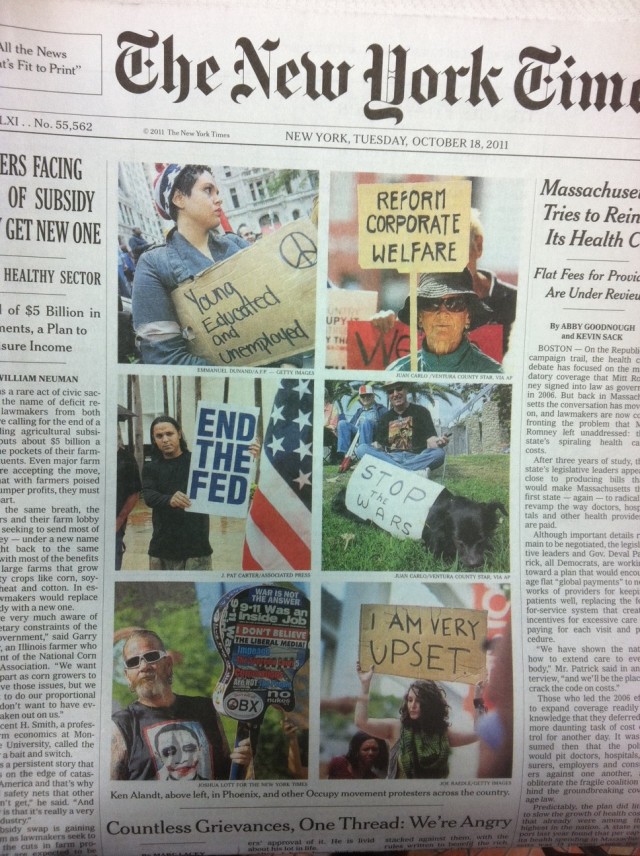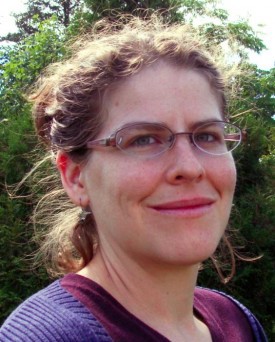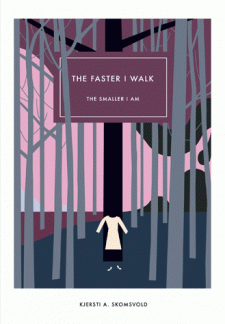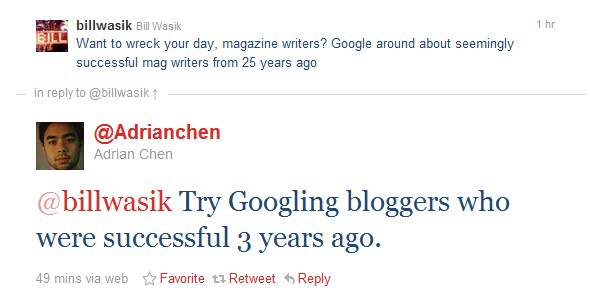Incredible Encounter With Whale Incredible Reminder Of Why You Should Just Stay On Land
“A Redondo Beach kayaker has posted a video on YouTube of an incredible encounter with a blue whale earlier this month…. He posted guidelines from the National Marine Fisheries Service, which note that a whale’s behavior should not be interrupted because doing so can cause them to rapidly change direction or swim in an erratic pattern, which can have major consequences for any human-size creatures in the area.” Which, uh, yeah.
What's Acceptable In Britain
“It’s one thing hitting someone in the face. But to use a bottle on someone you don’t know is just outrageous.”
— Glassing victim Amy Steel speaks out about the attack in a Newcastle club which left her with permanent facial scarring.
The 'NYT' Occupy Wall Street Front Pager Was an Inside Job

Kay Merryweather, 34, an artist on the Lower East Side, volunteers at Trinity Church, giving out food. She said that during the financial crisis, when banks were receiving bailouts and financial executives were receiving multimillion-dollar bonuses, the church often ran out before the long lines of working poor were fed. “The bankers were getting all of these millions,” Ms. Merryweather said. “And we didn’t have enough food.”
But not far away, Benny Zable, 66, a longtime activist, was protesting while wearing a gas mask and a suit that read “Work Consume Be Silent Die.” He said his outrage came from the heedlessness of economic growth. “It’s the greed factor,” Mr. Zable said.
“But”? “But”??? That actually isn’t at all a “but” transition, you know! Or you don’t. Picture the conference call between the desk in New York, the lead writer and the stringers: “This movement seems fractured and confused!” says the editor. “Did you find any people who seem fractured and confused?” The stringers mumble. “Fine, I’ve got one! I’ll write this anecdotal opening thing in myself,” says the lead writer, Times’ Phoenix bureau chief Marc Lacey. “See, I’ve got a great 9/11 ‘truther’ wingnut with all kinds of stickers on his guitar case!” (Hmm, pretty well-aged stickers though, right? Pretty sure that guy was already “there” long before the Occupy movement came into being last month.) “Oh and! I’ve got some chick from Code Pink!” Everyone on the conference call goes oooh. “Jackpot,” says the desk in New York, a few blocks from where thousands of people have just completely filled Times Square the other day. With a liberal media like this, who needs Fox News?
Chuck Berry Is 85
Charles Edward Anderson Berry, composer of such enduring American classics as “Johnny B. Goode,” “No Particular Place To Go,” “Maybellene” and “Surfin’ USA” turns 85 years old today. There are few words that can adequately convey his towering legacy, so just listen to the music.
Translating A Norwegian First Novel: A Q. & A. With Kerri Pierce
by Alicia Kennedy

“Awkward” is an overused word that has, over time, come to connote an almost endearing shyness. Its actual meanings, though — difficult, ungainly, abnormal — perfectly describe Mathea Martinsen, the narrator of Norwegian writer Kjersti A. Skomsvold’s debut novel, The Faster I Walk, The Smaller I Am. The book, out next week from Dalkey Archive, takes up Mathea’s life after the death of her husband. With no one to talk to, she wears a watch in the hopes that someone will ask her the time, talks to the news anchors on TV and repeatedly calls the operator asking for her own number. It’s a painfully funny exploration of loneliness, written in a lean prose that’s been translated from Norwegian into English by Kerri A. Pierce.
A prolific translator, Pierce works in seven languages — German, Danish, Dutch, Portuguese, Spanish, Norwegian, and Swedish — and is pursuing a doctorate in comparative literature at Penn State. We talked about how she picked up all those languages as well as what it was like to translate a book about such a strange character.
Alicia Kennedy: What drew you to the study of languages, and to translation?
Kerri Pierce: I’ve been interested in languages for as long as I could remember. In fact, one of my earliest memories is my excitement at discovering that there were other languages in the world, other ways of naming things. (I grew up in a single-language household.) Even though I’ve always enjoyed the study of languages, it’s only recently that I discovered (or, rather, fell into) translation. I applied for an editorial position at Dalkey Press and eventually ended up as a translation fellow. Before that, translation wasn’t something to which I’d given much thought to doing. It wasn’t until I was actually practicing it that I discovered how much I enjoyed the art.
How did you acquire seven languages, especially considering that you grew up with just one?
I guess my language experience has been somewhat nomadic, if I can use that term. I’ve had exposure to Spanish since about first grade. As time went on, I also learned to read Portuguese. However, I haven’t done much work (either translation work or academic work) in Spanish or Portuguese. I started studying German at the university level as an undergraduate. (I was a double major in German and English.) My first year in graduate school was spent in Flensburg, Germany. Since Flensburg is situated right on the Danish border, they offered classes in Danish at the University of Flensburg. A couple of years later I spent a semester in Aarhus, Denmark (ironically enough, just over the border from Flensburg). I took advantage of the location to acquire a bunch of books in both Norwegian and Swedish. Dutch is something I also picked up along the way, although I can’t tell you where. My shelves, however, are filled with foreign-language books: languages I’ve learned, am learning, would like to learn…
How did the transition from editorial work at Dalkey to translation happen? It seems like a big leap.
I never actually did editorial work with Dalkey. I applied for an editorial position and John O’Brien, the founder, suggested that translation would suit me much better. And it did!
You’ve been rather prolific since getting into the field: Dalkey Archive has put out four of your translations in two years, in three different languages. What is the experience of switching among them (and their respective cultural contexts) like?
The experience has been intense, frustrating, challenging and very enjoyable. I think that the experience of “getting into” a particular work itself helps establish my focus, and makes switching in between texts and languages doable. That and the fact that I’m translating texts into English, rather than trying to translate English into a series of different languages.
It seems there are two schools of translators: those in academia, and those who are writers themselves. How do your academic and translating careers complement each other, if at all?
First let me say that I think that the separation of academia (as institution) from the creative-writing act is an unfortunate construction. Personally, I do not regard the two as mutually exclusive. However, I am aware that creative writing, not to mention translation, is oftentimes seen as an “un-academic” activity. In my opinion, however, translation is a marriage of theory and praxis. It is an act of reading that takes place on various levels, both critical and creative. It demands both critical distance and a creative approach. As such, I tend to look at my academic training as a good preparation for a career in translation and vice versa.

How did that understanding of the work help in the translation of Kjersti A. Skomsvold’s The Faster I Walk, The Smaller I Am?
I think that The Faster I Walk, The Smaller I Am required a lot of attention to detail. Although the work itself is short, the text is surprisingly complex — and by complex, I mean compact. Skomsvold has an engaging elliptical style, which was important to keep in mind as both a translator and a reader.
Mathea, the narrator, is a pathologically awkward, intensely alienated person. She repeatedly uses famous quotes in an attempt to give meaning to her life: “The weather report is over, the meteorologist bids me good night, I say thank you while I gnaw on my cucumber and think about bite marks. I’m thinking about them because Descarte says I think, therefore I am.” Her story’s both funny and crushing. How did the “elliptical style” in which she was originally written affect how you re-created her in English?
In the first place, I think that the style of the book required a variety of re-readings to make sure I was getting the translation right. I particularly remember one passage, where out of the blue Mathea refers to fork marks on the wall. The reference is totally out of context for the scene and I remember reading the passage several times and saying to myself — “Fork marks, really?” — before finally being convinced I’d gotten the words right. Like many things in the text, it’s not until later that the reader gets the “back story” behind, in this case, fork marks. As a result, you might say that I took an “elliptical” approach to translation.
The novel won a prestigious first book prize in Norway. Aside from that recognition, why did you think it was an important book to bring to an English-reading audience?
The short answer is, I think it’s a damn good book.
I loved the story “dona malva and senhor josé ferreiro” by Valter Hugo Mãe that you translated from Portuguese for Best European Fiction 2010; the series has become a cool way to discover new writers. Are you currently reading anything new and great (in any language), and is there anyone you’re interested in translating?
Yes, I liked that story too. As to reading anything new and great — I’m finishing up a dissertation, so I have to admit that my reading has been somewhat limited to journal articles and the latest draft of my thesis. (I’d love to call that “new and great,” but…) In terms of translating, there are a couple of things that I’ve seen in the past few months that I’ve thought would make excellent projects. A couple of books in Norwegian, one in Danish.. .I’m also very excited about a project that is coming out in print soon from Dalkey Press: Assisted Living by the Swedish author, Nikanor Teratologen!
Alicia Kennedy is a copy editor, yogi and amateur baker. She is maybe not as boring as that makes her sound.
Throwing Muses, Live on Tour
Now about to tour Europe, the band Throwing Muses was formed thirty years ago now, long before any of the kids today were born. Over the last week, they played again, coming up the east coast. Now, I’m biased, because they’ve been my favorite band since I was a kid, but it’s sort of amazing to go to a rock show and discover that your favorite band from Ye Olden Times is actually the most bad-ass rock ’n’ roll trio playing today.
The material is still shocking, and its time signature fun and all-in tight weirdness paved the way for PJ Harvey’s original trio in 1991 (which, on her first trip to America, put on the single most face-obliterating rock show I’ve ever seen. I’m still a little deaf).
But it’s the actual rock-making that’s so exceptional about Throwing Muses. Watching Dave Narcizo play drums — he hits so many drums so often! Surely more and more often than is needed, which is his particular genius, and when he gets up from encores, the seat of his pants is soaked with sweat — points to a central feature of the band’s weirdness. That is: did they just start making songs like this in 1981 because they could, or because no one told them they couldn’t, or what is the deal? Did they just not know how to play their instruments right? And that’s why the songs came out in this wackadoo fashion? That they’d put these rolling slightly bluesy basslines on top of hard art rock guitar backed by a guy who liked to drum like a hick from the sticks in a psycho marching band is really not a thing that makes sense.
For a little historical context of the sounds in the air of 1981, X released their first album, “Los Angeles,” in 1980. REM’s “Murmur” came out in 1983. The Pixies toured as Throwing Muses’ opening act, before recording “Come on Pilgrim,” which wasn’t released until 1987. Slint formed in 1986. Sonic Youth also formed in 1981, tellingly, but then so did the Pet Shop Boys.
That Throwing Muses is on tour I bet feels like a challenge, because there’s nothing worse to imagine than a 30-year-old band trudging its way through its discography. That has the opportunity to be so bad! But live, and playing the great small venues, with no stage show, everyone all casual, Throwing Muses emphasizes its weird roots — from the live versions you get a lot more old-school metal from guitar and bass, and a bit more rockabilly from drums. So instead of a cringey sad trip, you get a monster rough and ready rock band that’d absolutely freak people out if they were coming up in Brooklyn today.
And you also get a band that was extremely young when they started, and so you see them coping with performing some of what is, essentially, juvenilia. (The bonus thing about starting young (though Bernard Georges, equally good-looking, didn’t join the band till 1992) is that each of them looks fabulous today.) Down to the name — Throwing Muses is a TERRIBLE name for a band! Yet sort of wonderful, in the way of all things we dream up when we’re young — to the delicious melodrama of the first album and the first four EPs in particular, a mature band has to face down its excesses. Go ask a writer to read from the stuff they wrote thirty years ago; most would want to crawl in a hole and die. That a band can bring fresh perspective and meaningful interpretation to their early material live, and make it totally kill on-stage — well, I really don’t want to see very many of my other heroes try it.
Live in 1987:
Live in 2001:
Live in 2009:
Live last week:
Everything Not To Do
Everything Not To Do

“Eventually in your life you will come home at four in the morning and vomit all over your toilet because you didn’t make it time to lift the lid. Sorry, but it’s true. Deal with it. Now, after you’ve finished vomiting and also trying to figure out why you’re vomiting blood (you are too drunk to remember that you drank red wine), you’ve got a major mess on your hands that needs to be cleaned. Luckily, you’re already in the right place because there’s a surplus of paper products and also a toilet, which is like a magical trash can that will help you erase all of your mistakes. BUT ONLY IF YOU DO IT RIGHT.”
— Very little is more thrilling than advice that is terrible in every way.
The JFK/OWS Connection
You catch that thing on Friday where the New York Times brought together an Occupy Wall Street protester and a Wall Street broker to discuss the issues? (For the purposes of this post let’s pretend that you did.) Well, if the protester seemed a little familiar (again, just go with it), there’s a good reason: he’s the guy who jumped the baggage carousel at JFK at the beginning of the year. We chatted with him back in February. Small world!
What's Your Share Of The U.S. Binge Drinking Deficit?
“Excessive alcohol consumption cost the U.S. about $224 billion, according to a new report from the Centers for Disease Control and Prevention.” And I helped!

